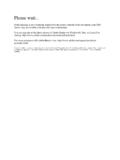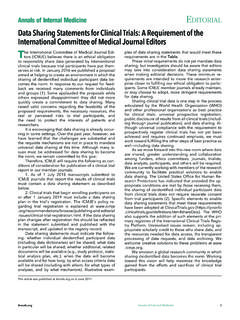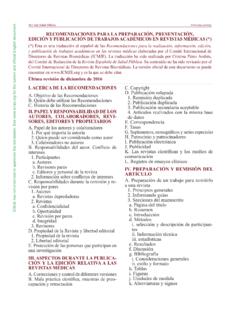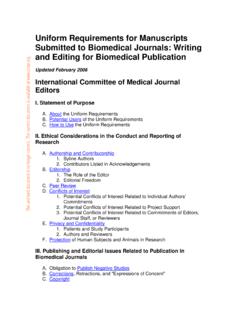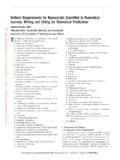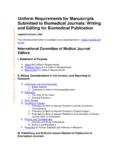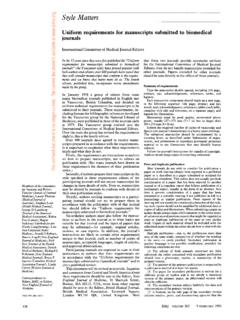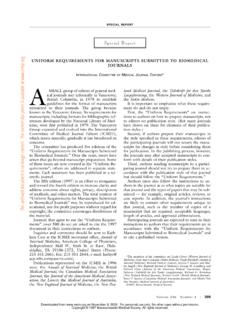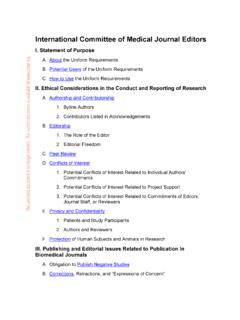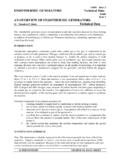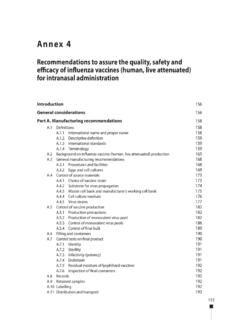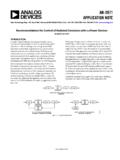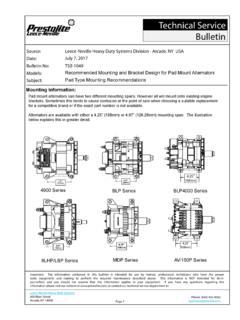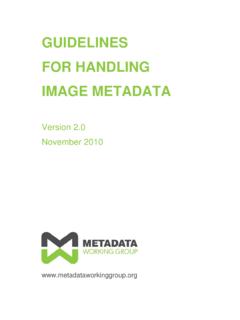Transcription of Recommendations for the Conduct, Reporting, …
1 Recommendations for the Conduct, Reporting, Editing, andPublication of Scholarly Work in Medical JournalsUpdated December 2017I. About the RecommendationsA. Purpose of the RecommendationsB. Who Should Use the Recommendations ?C. History of the RecommendationsII. Roles and Responsibilities of Authors, Contributors,Reviewers, Editors, Publishers, and OwnersA. Defining the Role of Authors and Contributors1. Why Authorship Matters2. Who Is an Author?3. Non-Author ContributorsB. Author Responsibilities Conflicts of Interest1. Participantsa. Authorsb. Peer Reviewersc. Editors and Journal Staff2. Reporting Conflicts of InterestC. Responsibilities in the Submission and Peer-ReviewProcess1. Authorsa. Predatory Journals2. Journalsa. Confidentialityb. Timelinessc. Peer Reviewd. Integrity3. Peer ReviewersD. Journal Owners and Editorial Freedom1. Journal Owners2. Editorial FreedomE. Protection of Research ParticipantsIII.
2 Publishing and Editorial Issues Related to Publicationin Medical JournalsA. Corrections and Version ControlB. Scientific Misconduct, Expressions of Concern,and RetractionC. CopyrightD. Overlapping Publications1. Duplicate Submission2. Duplicate Publication3. Acceptable Secondary Publication4. Manuscripts Based on the Same DatabaseE. CorrespondenceF. FeesG. Supplements, Theme Issues, and Special SeriesH. Sponsorship of PartnershipsI. Electronic PublishingJ. AdvertisingK. Journals and the MediaL. Clinical Trialsi. Registrationii. Data SharingIV. Manuscript Preparation and SubmissionA. Preparing a Manuscript for Submission to a Med-ical Journal1. General Principles2. Reporting Guidelines3. Manuscript Sectionsa. Title Pageb. Abstractc. Introductiond. Methodsi. Selection and Description of Participantsii. Technical Informationiii. Statisticse. Resultsf. Discussiong. Referencesi. General Considerationsii. Style and Formath.
3 Tablesi. Illustrations (Figures)j. Units of Measurementk. Abbreviations and SymbolsB. Sending the Manuscript to the JournalI. ABOUT THERECOMMENDATIONSA. Purpose of the RecommendationsICMJE developed these Recommendations to reviewbest practice and ethical standards in the conduct and re-porting of research and other material published in medicaljournals, and to help authors, editors, and others involvedin peer review and biomedical publishing create and dis-tribute accurate, clear, reproducible, unbiased medical journalarticles. The Recommendations may also provide useful in-sights into the medical editing and publishing process for themedia, patients and their families, and general Who Should Use the Recommendations ?These Recommendations are intended primarily for useby authors who might submit their work for publication toICMJE member journals. Many non-ICMJE journals vol-untarily use these Recommendations (see ).
4 The ICMJE encourages that use but hasno authority to monitor or enforce it. In all cases, authorsshould use these Recommendations along with individualjournals instructions to authors. Authors should also con-sult guidelines for the reporting of specific study types( , the CONSORT guidelines for the reporting of ran-domized trials); see S 61 1/12/18 11:40 Art:Journals that follow these Recommendations are en-couraged to incorporate them into their instructions toauthors and to make explicit in those instructions that theyfollow ICMJE Recommendations . Journals that wish to beidentified on the ICMJE website as following these recom-mendations should notify the ICMJE secretariat via e-mailat Journals that in the past have re-quested such identification but who no longer followICMJE Recommendations should use the same means torequest removal from this ICMJE encourages wide dissemination of theserecommendations and reproduction of this document in itsentirety for educational, not-for-profit purposes withoutregard for copyright, but all uses of the recommendationsand document should direct readers to forthe official, most recent version, as the ICMJE updates therecommendations periodically when new issues History of the RecommendationsThe ICMJE has produced multiple editions of thisdocument, previously known as the Uniform Require-ments for Manuscripts Submitted to Biomedical Journals(URMs).
5 The URM was first published in 1978 as a wayof standardizing manuscript format and preparation acrossjournals. Over the years, issues in publishing that went wellbeyond manuscript preparation arose, resulting in the de-velopment of separate statements, up-dates to the docu-ment, and its renaming as Recommendations for theConduct, Reporting, Editing, and Publication of ScholarlyWork in Medical Journals to reflect its broader versions of the document may be found in the Archives section of ROLES ANDRESPONSIBILITIES OFAUTHORS,CONTRIBUTORS,REVIEWERS,EDITORS ,PUBLISHERS,ANDOWNERSA. Defining the Role of Authors and Contributors1. Why Authorship MattersAuthorship confers credit and has important aca-demic, social, and financial implications. Authorship alsoimplies responsibility and accountability for publishedwork. The following Recommendations are intended toensure that contributors who have made substantive intel-lectual contributions to a paper are given credit as authors,but also that contributors credited as authors understandtheir role in taking responsibility and being accountable forwhat is authorship does not communicate what con-tributions qualified an individual to be an author, somejournals now request and publish information about thecontributions of each person named as having participatedin a submitted study, at least for original research.
6 Editorsare strongly encouraged to develop and implement a con-tributorship policy. Such policies remove much of the am-biguity surrounding contributions, but leave unresolvedthe question of the quantity and quality of contributionthat qualify an individual for authorship. The ICMJE hasthus developed criteria for authorship that can be used byall journals, including those that distinguish authors fromother Who Is an Author?The ICMJE recommends that authorship be based onthe following 4 criteria:1. Substantial contributions to the conception or de-sign of the work; or the acquisition, analysis, or interpre-tation of data for the work; AND2. Drafting the work or revising it critically for im-portant intellectual content; AND3. Final approval of the version to be published; AND4. Agreement to be accountable for all aspects of thework in ensuring that questions related to the accuracy orintegrity of any part of the work are appropriately investi-gated and addition to being accountable for the parts of thework he or she has done, an author should be able toidentify which co-authors are responsible for specific otherparts of the work.
7 In addition, authors should have confidencein the integrity of the contributions of their those designated as authors should meet all fourcriteria for authorship, and all who meet the four criteriashould be identified as authors. Those who do not meet allfour criteria should be acknowledged see Section These authorship criteria are intended to reserve thestatus of authorship for those who deserve credit and cantake responsibility for the work. The criteria are not in-tended for use as a means to disqualify colleagues fromauthorship who otherwise meet authorship criteria by de-nying them the opportunity to meet criterion #s 2 or , all individuals who meet the first criterionshould have the opportunity to participate in the review,drafting, and final approval of the individuals who conduct the work are responsiblefor identifying who meets these criteria and ideally shoulddo so when planning the work, making modifications asappropriate as the work progresses.
8 It is the collective re-sponsibility of the authors, not the journal to which thework is submitted, to determine that all people named asauthors meet all four criteria; it is not the role of journaleditors to determine who qualifies or does not qualify forauthorship or to arbitrate authorship conflicts. If agree-ment cannot be reached about who qualifies for author-ship, the institution(s) where the work was performed, notthe journal editor, should be asked to investigate. If au-thors request removal or addition of an author after man-uscript submission or publication, journal editors shouldseek an explanation and signed statement of agreement forthe requested change from all listed authors and from theauthor to be removed or corresponding author is the one individual whotakes primary responsibility for communication with thejournal during the manuscript submission, peer review, Recommendations for the Conduct, Reporting, Editing, and Publication of Scholarly Work in Medical S 61 1/12/18 11:40 Art:and publication process, and typically ensures that all thejournal s administrative requirements, such as providingdetails of authorship, ethics committee approval, clinicaltrial registration documentation, and gathering conflict ofinterest forms and statements, are properly completed, al-though these duties may be delegated to one or more co-authors.
9 The corresponding author should be availablethroughout the submission and peer-review process to re-spond to editorial queries in a timely way, and should beavailable after publication to respond to critiques of thework and cooperate with any requests from the journal fordata or additional information should questions about thepaper arise after publication. Although the correspondingauthor has primary responsibility for correspondence withthe journal, the ICMJE recommends that editors send cop-ies of all correspondence to all listed a large multi-author group has conducted thework, the group ideally should decide who will be an au-thor before the work is started and confirm who is anauthor before submitting the manuscript for members of the group named as authors should meetall four criteria for authorship, including approval of thefinal manuscript, and they should be able to take publicresponsibility for the work and should have full confidencein the accuracy and integrity of the work of other groupauthors.
10 They will also be expected as individuals to com-plete conflict-of-interest disclosure large multi-author groups designate authorshipby a group name, with or without the names of individu-als. When submitting a manuscript authored by a group,the corresponding author should specify the group name ifone exists, and clearly identify the group members who cantake credit and responsibility for the work as authors. Thebyline of the article identifies who is directly responsiblefor the manuscript, and MEDLINE lists as authors which-ever names appear on the byline. If the byline includes agroup name, MEDLINE will list the names of individualgroup members who are authors or who are collaborators,sometimes called non-author contributors, if there is a noteassociated with the byline clearly stating that the individualnames are elsewhere in the paper and whether those namesare authors or Non-Author ContributorsContributors who meet fewer than all 4 of the abovecriteria for authorship should not be listed as authors, butthey should be acknowledged.
